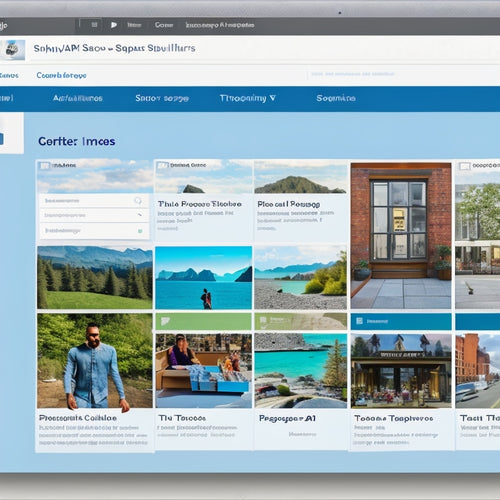
Ecommerce Course Creation Strategies for Digital Success
Share
You know that creating high-demand online courses can be a game-changer for your digital success in ecommerce. To get started, you'll need to identify profitable course topics through market research and audience validation. Then, craft engaging course content with clear objectives, interactive experiences, and real-world examples. Structure your course curriculum effectively with logical modules, diverse content formats, and interactive features. Don't forget to create visual aids and assets, and build interactive learning experiences with gamification elements and real-world simulations. By mastering these ecommerce course creation strategies, you'll be well on your way to driving sales and attracting students - and there's even more to explore.
Key Takeaways
• Identify profitable ecommerce course topics through market research and audience validation to create relevant content.
• Craft engaging ecommerce course content with clear objectives, interactive experiences, and real-world examples to enhance learning.
• Structure ecommerce course curriculum effectively with logical modules, diverse content formats, and interactive features for better retention.
• Implement gamification elements and real-world scenario simulations to increase engagement, motivation, and critical thinking skills.
• Strategically price and position ecommerce courses based on value proposition, competitive analysis, and target audience willingness to pay for maximum revenue generation.
Identifying Profitable Course Topics
To establish a profitable ecommerce course, you need to identify topics that resonate with your intended audience and have a high demand in the market, which is why researching popular trends, pain points, and market gaps is crucial. You can't just develop a course spontaneously; you need to understand what your audience desires and requires. This is where market analysis comes into play. By conducting comprehensive market research, you'll uncover the topics that are highly sought after, and more importantly, what's currently lacking in the market.
You'll also acquire a deeper comprehension of your target audience, including their pain points, objectives, and incentives. This will allow you to create a course that addresses their specific requirements and offers valuable solutions. Don't presume you know what your audience desires; instead, take the time to research and validate your concepts. This will guarantee that your course resonates with your intended audience and ultimately boosts sales.
Crafting Engaging Course Content
Now that you've identified a profitable course topic, it's time to create engaging content that resonates with your students.
To do this, you'll need to define clear objectives for each lesson, create interactive experiences that promote learning, and use storytelling techniques to make complex concepts more relatable.
Define Clear Objectives
By establishing clear objectives, you'll create a roadmap for your ecommerce course content that resonates with your target audience and drives meaningful engagement. This means setting specific, measurable, achievable, relevant, and time-bound (SMART) goals that outline what you want your students to accomplish. By doing so, you'll be able to measure the success of your course and make data-driven decisions to improve it.
Clear objectives are vital for student engagement, as they provide a clear direction and focus for your course content. When you know exactly what you want your students to learn, you can create targeted lessons that meet their needs and interests. This, in turn, boosts student motivation and participation, leading to a more interactive and immersive learning experience.
Create Interactive Lessons
You'll capture your students' attention and encourage active learning by incorporating a variety of interactive elements into your ecommerce course lessons, such as quizzes, gamification, and real-world examples. These components will break up the monotony of passive learning and keep students engaged.
Interactive quizzes, for instance, can provide immediate feedback, helping students identify areas where they need to improve. You can also use gamification to make learning fun and competitive, fostering a sense of accomplishment as students progress through the course.
Collaborative projects and discussions are another way to encourage interactivity. By assigning group projects or hosting online discussions, you'll create opportunities for students to share their experiences, ask questions, and learn from one another. This type of collaboration can lead to valuable insights and new perspectives, making the learning experience more dynamic and effective.
Use Storytelling Techniques
In ecommerce course creation, storytelling techniques can be a powerful tool for crafting engaging content that resonates with students and makes complex concepts more relatable. By incorporating storytelling elements, you can create a connection with your students that goes beyond just conveying information.
When you use storytelling, you're not just teaching ecommerce concepts, you're sharing a narrative that students can identify with.
Here are some ways to use storytelling techniques in your ecommerce course:
-
Develop relatable characters: Create characters that students can identify with, and use their experiences to illustrate key concepts.
-
Use emotional connections: Share personal anecdotes or customer testimonials that evoke emotions and make the learning experience more memorable.
-
Create a narrative arc: Structure your course content to follow a narrative arc, with a clear beginning, middle, and end that builds tension and resolution.
- Use vivid imagery: Use descriptive language to paint a picture in your students' minds, making the learning experience more immersive and engaging.
Structuring Course Curriculum Effectively
Crafting a well-organized curriculum is crucial in developing an ecommerce course that connects with students and prepares them for success. You want to make certain that your curriculum is structured in a manner that promotes student engagement and motivates them to learn.
To accomplish this, begin by breaking down your course into modules or topics that flow logically. This will assist you in establishing a clear learning pathway for your students.
Next, concentrate on lesson structure. Each lesson should have a distinct goal, and the content should be presented in a way that's easy to comprehend. Consider incorporating a variety of text, visuals, and videos to maintain student interest.
Be sure to integrate interactive features, such as quizzes or online discussion boards, to stimulate participation. By organizing your curriculum efficiently, you'll be able to share your ecommerce knowledge in an informative and captivating manner. This will result in increased student satisfaction and, ultimately, greater success in the ecommerce industry.
Creating Visual Aids and Assets
As you structure your ecommerce course curriculum, don't forget to create visual aids and assets that bring your lessons to life and help students absorb complex concepts more easily. These visual elements won't only enhance the learning experience but also reinforce your brand's identity and design aesthetics.
Here are some essential visual aids and assets you should consider creating:
-
Infographics: Break down complex information into easily digestible visuals that illustrate key concepts, statistics, or processes.
-
Animations: Use motion graphics or animated videos to explain complex topics, demonstrate software tutorials, or showcase product features.
-
High-quality images: Use relevant, high-resolution images to illustrate key concepts, showcase products, or demonstrate techniques.
- Custom illustrations: Create unique, branded illustrations that reflect your brand's personality and style, adding a touch of personality to your lessons.
Building Interactive Learning Experiences
As you build interactive learning experiences for your ecommerce course, you'll want to focus on incorporating engaging visual elements that capture learners' attention and encourage participation.
You'll also need to contemplate how to effectively use gamification in learning to motivate learners and boost engagement.
Engaging Visual Elements
To capture learners' attention and boost engagement, incorporate a variety of engaging visual elements, such as animated GIFs, interactive simulations, and 3D models, into your ecommerce course. This won't only make your content more appealing but also help learners retain information better.
Here are some ways to make the most of visual elements:
-
Establish a strong visual brand: Develop a consistent visual identity that reflects your brand's personality and resonates with your target audience.
-
Use color psychology: Select colors that evoke the right emotions and convey the desired message, making your content more engaging and memorable.
-
Create interactive simulations: Design interactive simulations that allow learners to experiment and learn through hands-on experiences.
- Incorporate graphic design: Use high-quality graphics, icons, and illustrations to break up text and make your content more scannable and engaging.
Gamification in Learning
You can increase learner engagement and motivation by incorporating game design elements into your ecommerce course, leveraging the psychological triggers that make games so addictive and enjoyable.
By tapping into the human desire for competition, achievement, and social interaction, you can create a more immersive and interactive learning experience.
This is where gamification comes in - a powerful tool for boosting player engagement and motivation.
By incorporating game design elements such as rewards, challenges, and leaderboards, you can create an environment that encourages learners to participate, interact, and learn.
For instance, you can create a points system where learners earn badges or rewards for completing modules or achieving specific milestones.
This not only increases learner engagement but also fosters a sense of accomplishment and satisfaction.
Real-World Scenario Simulations
By incorporating real-world scenario simulations into your ecommerce course, learners can practice applying concepts to realistic, high-stakes situations, making the learning experience more immersive, interactive, and effective. This approach allows learners to develop critical thinking and problem-solving skills in a risk-free environment, building confidence in their abilities before applying them in real-world scenarios.
Here are some ways to incorporate real-world scenario simulations into your ecommerce course:
-
Role-playing exercises: Create scenarios where learners take on different roles, such as customer service representatives or marketing managers, to practice resolving customer complaints or developing marketing strategies.
-
Virtual simulations: Develop interactive simulations that mimic real-world ecommerce scenarios, such as managing inventory or optimizing website performance.
-
Problem-solving scenarios: Design scenarios that present learners with real-world ecommerce challenges, such as resolving shipping issues or managing returns.
- Interactive workshops: Host live or virtual workshops where learners can participate in group activities, such as brainstorming sessions or case studies, to practice applying ecommerce concepts in real-world scenarios.
Pricing and Positioning Courses Strategically
Setting a price for your ecommerce course requires careful evaluation of its value proposition, target audience, and competitive landscape to guarantee strategic positioning in the market. You need to conduct a competitive analysis to understand what similar courses are offering and how you can differentiate yours.
Identify your unique value proposition and determine how it will benefit your students. This will help you set a price that reflects the value you're providing.
You also need to assess your target audience and their willingness to pay. Conduct market research to understand their pain points, budget, and preferences. This will help you price your course in a way that resonates with them.
Don't underestimate the importance of pricing; it can make or break your course's success. If you price too low, you may attract a large audience but sacrifice revenue. If you price too high, you may deter potential customers. By finding the sweet spot, you can attract the right students and generate revenue.
Launching and Marketing Courses Successfully
With your ecommerce course strategically positioned and priced, it's time to develop a launch and marketing plan that drives sales and attracts students. You've done the hard work, now it's time to showcase your expertise and get your course in front of the right audience.
To secure a successful launch, focus on the following strategies:
-
Build anticipation: Create a buzz around your course by sharing behind-the-scenes content, sneak peeks, and exclusive offers on social media.
-
Leverage email campaigns: Build an email list and send targeted campaigns to promote your course, share testimonials, and provide valuable content that resonates with your audience.
-
Collaborate with influencers: Partner with industry thought leaders or influencers to reach new audiences, build credibility, and generate buzz around your course.
- Optimize for SEO: Secure that your course website and marketing materials are optimized for search engines to improve visibility and drive organic traffic.
Frequently Asked Questions
Can I Create an Ecommerce Course With No Prior Teaching Experience?
You can create a course without prior teaching experience, but you'll need to focus on marketing tactics that showcase your expertise and audience engagement strategies to build trust with potential students.
How Do I Handle Copyright Issues With Course Materials and Assets?
When using others' materials in your course, you'll need to navigate copyright issues. You can claim fair use, but be cautious; instead, consider obtaining licensing agreements to guarantee you're legally protected and avoid potential lawsuits.
What if My Course Content Becomes Outdated Quickly?
When your course content becomes outdated quickly, you'll need to stay ahead of industry trends and update regularly to maintain relevance, ensuring you continue to engage your audience and deliver value that keeps them coming back.
Can I Sell My Course on Multiple Platforms Simultaneously?
You can definitely sell your course on multiple platforms simultaneously, but be cautious of platform exclusivity agreements and market saturation, as they might dilute your sales and impact your brand's overall revenue.
How Do I Measure the Long-Term Success of My Ecommerce Course?
"You're no longer just launching a course, you're building a legacy. To measure long-term success, track metrics beyond sales, focusing on retention rates and survey feedback to gauge student engagement and true impact."
Related Posts
-

Assessing Ecommerce Digital Literacy for Merchant Success
You're already operating an ecommerce store, which means you're well aware of the importance of digital literacy in d...
-

Social Media Shopify Apps Boost a Store's Presence and Sales on Social Platforms, Offering Functionalities Like Post Scheduling and Ad Performance Tracking
This article examines the impact of social media Shopify apps on a store's presence and sales on various social plat...
-

How Do I Set up A Tracking Page on Shopify
This article aims to provide a comprehensive guide on setting up a tracking page on the Shopify platform. It explore...


